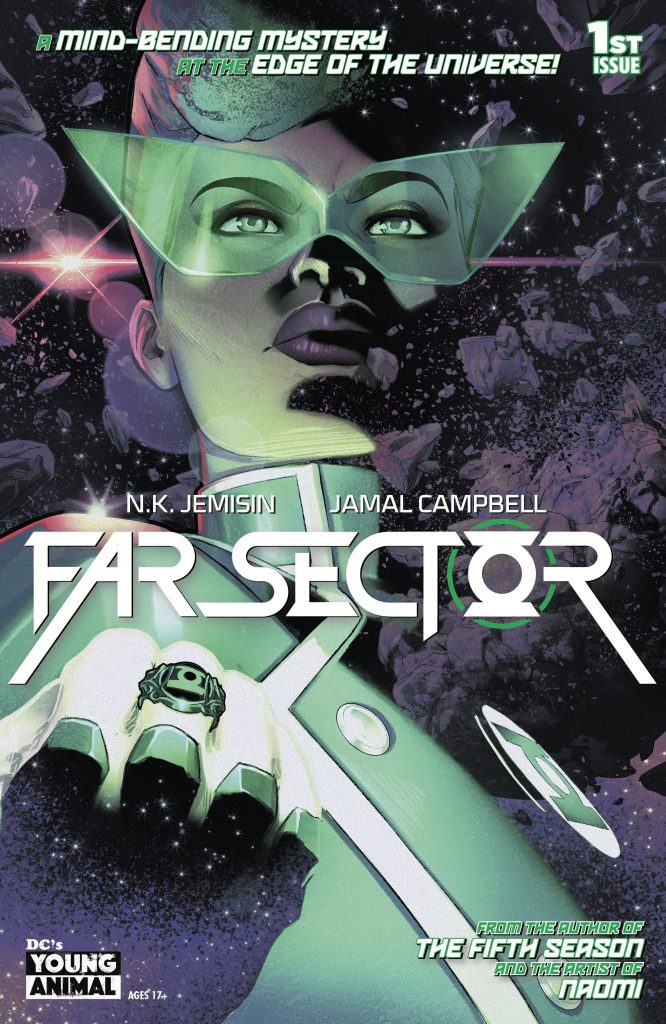
Comics Corner – Far Sector: DC’s most important comic stars a queer black female Green Lantern

If you’re not already a fairly committed comic book reader, chances are that if you know of Green Lantern at all, it’s via the doomed 2011 live action movie. Look past that flawed adaptation though, and you’ll find that Green Lantern is one of the richest concepts in the vast DC universe – and it’s currently providing the framework for the publisher’s best and most important title, Far Sector.

First, a brief comics history lesson. The first character to bear the mantle of Green Lantern was Alan Scott, who debuted in the pages of All-American Comics #16 in 1940, created by Martin Nodell. Wielding a magic ring capable of altering material properties and, later, forming solid objects from thin air, the original Green Lantern would go on to become one of the most popular superheroes of comics’ Golden Age – and, in 2012, be revamped on an alternate Earth as a gay man.
The Green Lantern concept was reimagined in 1959 by writer John Broome and Gil Kane, bringing in new character Hal Jordan who was established as just one of thousands of members of an interplanetary police force. Each officer patrolled a sector of the galaxy, armed with a technological power ring capable of generating solid light constructs. This has been the basis for almost all Green Lantern stories since, with the Green Lantern Corps upholding peace throughout space.
Far Sector is not like most Green Lantern comics though. Created by writer N.K. Jemisin and artist Jamal Campbell, it debuted in 2019 as part of DC’s Young Animal imprint – a line launched in 2016 by My Chemical Romance frontman Gerard Way, focussing on twists on some of DC’s lesser known characters and heralded by the tagline “Comics for Dangerous People”. Like most of the Young Animal line, Far Sector is slightly removed from the ‘main’ DC universe – it doesn’t bear the Green Lantern name anywhere on its covers, and its only link to the wider property is incorporation of the Green Lantern logo into the ‘O’ of the title. It is, so far, effectively standalone – which allows it to be far bolder in its stories and themes.

The series introduces Sojourner ‘Jo’ Mullein, a rookie Green Lantern from Earth, and the first black woman to wield the ring. Readers meet her mid assignment, patrolling the City Enduring – a Dyson Swarm in the distant reaches of the galaxy, built out of the remnants of two dead worlds, and inhabited by the three sentient races that once populated them. Despite having 20 billion residents, it’s a peaceful existence, ostensibly thanks to residents being genetically encoded with an Emotion Exploit to surpress their feelings. No rage, no jealousy, no passion – no crime. Of course, right as Jo shows up, the City Enduring is rocked by its first murder in 500 years.
Jo herself is a fascinating character. Her backstory has been drip-fed to readers over the six issues of Far Sector to date, and while there’s still much of her secret origin left to be told, she’s shown to have had stints in both the US military and the police. Fired from the latter after witnessing and reporting her white partner assaulting a black civilian, she’s offered the chance to become Earth’s newest Green Lantern, and sent to the City Enduring under still-mysterious circumstances. Her role differs from most Lanterns though, with the ring that gives her her powers having unique abilities and restrictions that other members of the Corps lack.
Jo is also openly queer. She is shown to have had relationships with male and female supporting characters, and when she’s recruited as a Green Lantern by a female Guardian of the Universe, Jo – drunk in a bar at the time – thinks she’s “out of [her] league”. Brilliantly, none of this is ever presented as a major event, but rather as a simple matter of humanity. There are no bold declarations of sexuality, just an almost absent-minded mentioning of characters she’s loved – or at least had sex with. Far Sector treats fluid sexuality and sex-positivity as a quiet default, not a stunt.

Far Sector is also simply a spectacular piece of art. Jemisin – perhaps best known outside of comics for her multiple Hugo Award-winning Broken Earth trilogy – builds a tapestry of big sci-fi ideas wrapped around complex sociological issues, while Cambell adds life and detail to the strange City Enduring with some of the most impressive art and design work to grace the printed page in years. It’s also refreshingly diverse. All too often in sci-fi, humanoid aliens are presented as caucasian – even if they have purple skin, they’ll have typically European features. In Far Sector, the fictional aliens are as varied as real humans, and it’s a delight to see.
As the series progresses, Far Sector morphs from a sci-fi murder mystery into something deeper, more complex, and more relevant to our real world. Jemisin and Cambell spring from the bombast of the murder to a closer examination of the society and politics of the City Enduring, using it to reflect on our own. Set against Jo’s investigations, an underground drug called Switchoff is becoming increasingly popular, used to temporarily re-activate people’s emotions – perhaps a metaphor for relaxing of drug laws and replacing with care-based initiatives. The pushback from the City Enduring’s political leaders comes swiftly though – and hypocritically, as at least one council leader regularly uses Switchoff himself. Most powerfully, a peaceful protest against the Emotion Exploit, which is forced on inhabitants without a choice, turns violent when the City Enduring’s ‘Peace Division’ fires, unprovoked, on protesters.

The production cycle for American comics is months-long. The events of recent issues of Far Sector would have been written and drawn long before the tragic killing of Breonna Taylor or George Floyd, among too many others, or the protests we’ve seen in recent weeks. Those were not isolated or new incidents though – Black Lives Matter has been a necessity for years, and even gets specifically name checked in one of Jo’s origin flashbacks. The energy and urgency of the real-world movement informs the underlying tensions in the City Enduring, and makes this an incredibly, if perhaps unexpectedly, timely and important comic. That it’s headlined by a queer black woman makes it even more so.
As Far Sector progresses, it will be fascinating to see how Jemisin and Campbell continue to explore these issues, and particularly Jo’s reactions to them. She has already left one police force behind in disgust, only to see the City Enduring’s answer to the police abuse their power in similar ways. Given the Green Lantern Corps is yet another police force, how those questions surrounding power and the responsible application of it – or if it can applied responsibly at all – are answered will make for powerful, crucial reading.
Far Sector is published by DC Comics. Issues are available in print from your local comic shop, or digitally via ComiXology.







